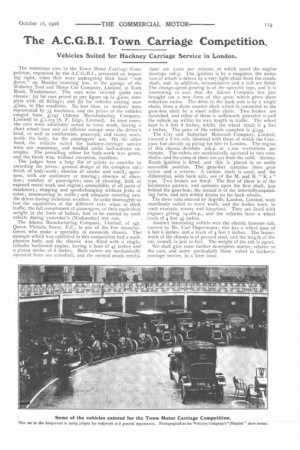The A.C.G.B.I. Town Carriage Competition.
Page 7

If you've noticed an error in this article please click here to report it so we can fix it.
Vehicles Suited for Hackney Carriage Service in London.
The numerous cars in the Town Motor Carriage Competition, organised by the A.C.G.B.I.; presented an imposingsight, when they were undergoing their final " rub down," on Monday morning last, in the garage of the Wolseley Tool and Motor Car Company, Limited, at York Road, Westminster.. The cars were entered under two classes : (a) for cars priced at any figure up to 600, corn-. plete with all fittings; and (b) for vehicles costing over Z600, in like condition. No less than 21 makers were represented by 33 machines, and the prices of the vehicles ranged from ,4;245 (Adams Manufacturing Company, Limited) to £1,225 (S. F. Edge, Limited). In most cases, the cars were admirably suited to town work, haying a short wheel base and an efficient canopy over the driver's head, as well as comfortable, protected, and roomy seats, inside the body, for the passengers' use. On the other hand, the vehicles suited for hackney-carriage service were not numerous, and totalled under half-a-dozen examples. The prevailing colour for body-work was green, and the finish was, without exception, excellent. The judges have a long list of -points to consider in awarding the prizes : general design of the complete car; finish of body-work; absence of smoke and smell ; quietness, with car stationary or moving; absence of vibration; comfort of passengers; ease of cleaning, both of exposed metal work and engine; accessibility of all parts of machinery; stopping and speed-changing without jerks or noise; manceuvring in traffic; and adequate covering over the driver during inclement weather. In order thoroughly to test the capabilities of the different cars when in thick traffic, the full complement of passengers, or their equivalent weight in the form of ballast, had to be carried by each vehicle during yesterday's (Wednesday) test run. The Adams Manufacturing Company, Limited, of 147, Queen Victoria Street, E.C., is one of the few manufacturers who make a speciality of motorcab chassis. The example which was exhibited in this competition had a mailphaeton body, and the chassis was fitted with a singlecylinder horizontal engine, having a bore of 41inches and a piston stroke of 6 inches. Both valves are mechanically operated from one camshaft, and the normal crank revolu
lions are f,000 per minute, at which speed the engine develops toh.p. The ignition is by a magneto, the armature of which is driven by a very light chain from the crankshaft, and, in addition, accumulators and a coil are fitted. The change-speed gearing is of the epicyclic type, and it is interesting to note that the Adams Company has just brought out a new form of this gear, which gives three reduction ratios. The drive to the back axle is by a single chain, from a short counter shaft which is connected to the gear-box shaft by a short roller chain. Two brakes are furnished, and either of these is sufficiently powerful to pull the vehicle up within its own length in traffic. The wheel base is 6 feet 8 inches, whilst the wheel track is 4 feet 2 inches. The price of the vehicle complete is £245.
The City and Suburban Motorcab Company, Limited, entered a Unic cab, identical with those of which the Company has already 25 plying for hire in London. The engine of this chassis develops foh.p. at 1,200 revolutions per minute. • The valves are mechanically operated by two camshafts, and the cams of these are cut from the solid. SimmsBosch ignition is fitted, and this is placed in an easily accessible position. The gear-box containsthree gear ratios and a reverse. A cardan shaft is used, and the differential, with back axle, are of the M. and B. " K 2 " type. Two brakes are fitted. The first of these is of the locomotive pattern, and operates upon the first shaft, just behind the gear-box; the second is of the internally-expanding form, and acts within drums on the back wheels.
The three cabs entered by Argylls, London, Limited, were excellently suited to town work, and the bodies were, in each example, roomy and luxurious. They are fitted with engines giving 14-16h.p., and the vehicles have a wheel track of 4 feet 4i inches.
Another interesting vehicle was the electric hansom cab, entered by Mr. Carl Oppermann; this has a wheel base of 6 feet 6 inches, and a track of 4 feet 7 inches. The framework of the chassis is of pressed steel, and the length of the car, overall, is just in feet. The weight of the cab is 29cwt.
We shall give sonic further descriptive matter, relative to the cars, and more particularly those suited to hackneycarriage service, in a later issue.
































